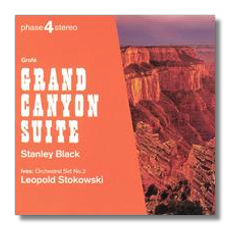
The Internet's Premier Classical Music Source
Related Links
- Latest Reviews
- More Reviews
-
By Composer
-
Collections
DVD & Blu-ray
Books
Concert Reviews
Articles/Interviews
Software
Audio
Search Amazon
Recommended Links
Site News
 CD Review
CD Review
Stokowski and Ives and ?

- Charles Ives: Orchestral Set #2
- Ferde Grofe: Grand Canyon Suite *
London Symphony Orchestra/Leopold Stokowski 1970
* London Festival Orchestra/Stanley Black
London "Phase Four" 448956-2
Okay, if you're like me the first thing that went through your mind, after you had done a double-take at reading the contents, was, "What moron marketer thought of this pairing?" Let's face facts, there are many collectors looking for a good Grand Canyon on a budget label series maintaining spectacular sound (and they deliver) who will pass this disc by because of the name, "Ives". That would be too bad. There are other tyros who might pick it up, having had some exposure to this music, attracted by the price as well, who would take the disc home (figuring this Ives-guy can't be too bad since his music must be like Grofe's) slap on the headphones and about the 7th track jump up, rip the headphones off and scream. That's a funny visual scenario…imagine the slowly changing facial expressions as Ives music creeps in, transforming the grand to the earthy (sorry) and the stench of the earth on a hot, rainy July….
Anyway, I digress. Sorry. Actually, while the two composers come from different sound worlds, they are not un-alike. In Ives you can hear him taking, not literally, from "a Grofe" and then doing variations on it. It has to be remembered that Grofe was celebrating one of the 7 Wonders of the World while Ives was marveling at the busy celebration called life, but both in the same era.
Ives' sound world was one of chaos, in the term as defined by Chaos Theory. I can think of no precedent, nor any explanation for the advent of his music. It is a perfect operational definition of: sui generis. If you are not familiar with Ives' sound world, an apt analogy is that he is to American Classical Music as is Walt Whitman to American poetry.
Orchestral Suite #2 has three movements. The first is titled "An Elegy to our Forefathers". It is actually, as Ives put it, an elegy to Stephen Foster. You can hear a backdrop of Swanee River as other music, sometimes atonal or dissonant, plays above it. It is kind of like a collage. The second movement is titled, "The Rockstrewn Hills join in the People's Outdoor Meeting. Here the chaotic, barbaric yawp of Whitman comes to mind. Ives captures the swirling, circus like tapestry of an old tent revival meeting. The final movement, "From Hanover Square North, at the End of a Tragic Day (1915), the voices of the People Rise Again" is one of my favorite. It is about the reaction of people in New York to hearing the news of the tragedy of the sinking of the Lusitania. It is variations on the gospel tune in the Sweet Bye and Bye. Here the sense of sadness rises slowly to a higher and deeper sense of disbelief, the voices of The People mix in a chaotic harmony that is truly moving. This effort on the part of Ives to capture the voice of the people is one area he shares with Whitman. Both artists wanted to capture the wonderful absurdity and energy of America and show how it was truly unique and alive. Sometimes in this last movement you can imagine you are on the streets of New York, listening to local bands playing badly but also sadly, capturing the sense of a crowd. At one point I realized it sounded like listening to a traffic jam, and I realized it might be just that in New York, though certainly a 1915 version. Ives captures the essence of the moment much like Whitman does in his poetry.
Okay, The Grand Canyon Suite, by Grofe, is not the most apt coupling. On the other hand it is not so odd as it may seem at first sight. This is one of the better recordings of Grofe's piece. The detail is nly recently been able to appreciate Ives. Oddly, I think my recent exposure and appreciation of Martinů has helped open this door. I am glad it did. I strongly recommend this recording to you.
Copyright © 1995, Robert Stumpf II


















